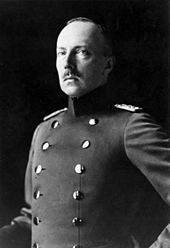Kingdom of Finland
The Kingdom of Finland ( Finnish Suomen kuningaskunta, Swedish Kungariket Finland ) was a fruitless attempt to establish a monarchy in Finland after the Grand Duchy of Finland became independent from the Russian Empire . At the end of the First World War , the German Empire tried to enthrone Friedrich Karl of Hesse as King of Finland.
history


Finland, which had been an integral part of Sweden since the Middle Ages , was ceded to Russia in 1809 and constituted as the autonomous "Grand Duchy of Finland". In the next 100 years Finland became a nation. After the Russian Civil War broke out, Finland declared its independence from what was then Soviet Russia on December 6, 1917 . At that time the monarchists were in the minority in the Finnish Parliament , but the Finnish Civil War , in which Imperial German troops intervened, prevented the proposal for a republican form of government from being debated. While the Social Democratic Party of Finland was excluded from parliament, the country was ruled by an imperial administrator and a new constitution had not yet been passed, Friedrich Karl von Hessen was elected King of Finland by parliament on October 9, 1918 in the area occupied by German troops.
Lithuania , also occupied by German troops, took a similar step in July 1918 and had elected Wilhelm Karl von Urach as King Mindaugas II. In Estonia and Latvia , the general provincial assembly, which was composed of Baltic German aristocrats, called on the German Kaiser Wilhelm II to recognize the Baltic provinces as a common monarchy and a German protectorate. Adolf Friedrich zu Mecklenburg was then proclaimed Duke of the United Baltic Duchy by the Baltic Germans .
Like the Baltic provinces, the Kingdom of Finland had close ties to the German Empire. Germany was the only major power that had supported the preparations for independence, not least by training volunteers with the Finnish hunters . Germany also intervened in the Finnish civil war, despite its own precarious situation at the end of the First World War . Finland's position alongside Germany in the spring of 1918 became, in effect, that of a protectorate, and the election of Prince Friedrich, brother-in-law of Kaiser Wilhelm II, was seen as confirmation of the close ties between the two nations.
After the adoption of a new monarchist constitution failed due to a lack of majorities in parliament, the (controversial) legitimacy of the king's election was based on the form of government of 1772, which was established by Gustav III. was introduced when Finland was still part of Sweden. The same constitutional document served as the basis for the election of Russian emperors as Finnish grand dukes during the 19th century .
Gustaf Arokallio, a member of the Finnish Parliament, suggested "Charles I, King of Finland and Karelia , Duke of Åland , Grand Duke of Lapland , Lord of Kalevala and the North " ( Finnish Kaarle I, Suomen ja Karjalan kuningas, Ahvenanmaan herttua, Lapinmaan suuriruhtinas, Kalevan ja Pohjolan isäntä ; Swedish Karl I, Kung av Finland och Karelen, hertig av Åland, storhertig av Lappland, herre över Kaleva och Pohjola ).
However, Friedrich Karl von Hessen did not accept the election as King of Finland. On November 9, 1918, the republic was proclaimed in Germany, and the German Kaiser Wilhelm II abdicated ( November Revolution ). Two days later, on November 11, 1918, the Compiègne armistice was signed, ending the war between Germany and the Western powers. The Entente states clearly opposed the election of a German prince as the Finnish king. Prime Minister Lauri Ingman - himself a monarchist - had no choice but to ask Prince Friedrich to renounce his royal dignity.
The elected but not yet crowned King Friedrich complied with this request on December 14, 1918. In the general election of 1919 Republican parties were given three-quarters of the seats, and Finland subsequently adopted a republican constitution.
Other similar states
During the First World War, the German Reich founded several puppet governments on the territory of the former Russian Empire . However, these states were neither fully independent nor sovereign.
- Duchy of Courland and Zemgale (1918)
- Kingdom of Lithuania
- Regency Kingdom of Poland
- United Baltic Duchy
Individual evidence
- ↑ Jalokivigalleria. In: experience365.fi. Retrieved October 21, 2018 .
- ↑ Ohto Manninen (päätoim.), Pertti Haapala, Juhani Piilonen, Jukka-Pekka Pietiäinen: Itsenäistymisen vuodet 1917–1920: 3. Katse tulevaisuuteen. Valtionarkisto, Helsinki 1992, ISBN 951-37-0729-6 , pp. 188-189
literature
- Anders Huldén, Finland's German King's Adventure 1918 , Reinbek 1997. Published by: German-Finnish Society eV and published by: Traute Warnke Verlag, ISBN 3-980-15919-1 .
- Rainer von Hessen: King in the "Land of Serious Eyes". The Finnish offer to the throne to Prince Friedrich Karl of Hesse in the summer of 1918. In: Bernd Heidenreich u. a. (Ed.): Crowns, Wars, Arts. The House of Hesse in the 19th and 20th centuries. Frankfurt 2009, pp. 190-204.
- Nash, Michael L (2012) The last King of Finland. Royalty Digest Quarterly , 2012: 1